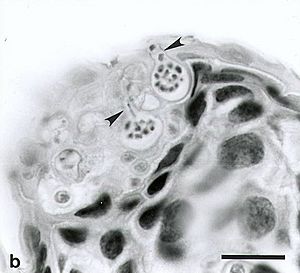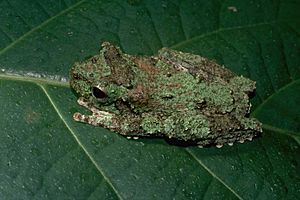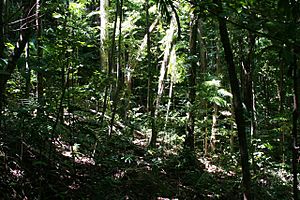Green-eyed treefrog facts for kids
Quick facts for kids Green-eyed treefrog |
|
|---|---|
 |
|
| Female green-eyed treefrog | |
| Conservation status | |
| Scientific classification | |
| Genus: |
Ranoidea (genus)
|
| Species: |
serrata
|
| Synonyms | |
|
List
|
|
The green-eyed treefrog (Ranoidea serrata) is a type of treefrog found in Australia. It lives in the "Wet Tropics" area of Queensland. This frog is part of the Pelodryadidae family, which includes many Australasian treefrogs.
Green-eyed treefrogs live in warm, wet places. Their homes include tropical forests, rivers, and freshwater marshes. They can also be found in gardens and even in areas where forests used to be. Sadly, their homes are shrinking because of habitat loss. They are also threatened by a serious frog disease called chytridiomycosis. These frogs are carnivores, meaning they eat other animals.
Amazing Frog Facts
Australia has nearly 230 different kinds of frogs. Most of them live in Queensland, a tropical part of the country. Green-eyed treefrogs have a fascinating history. Thousands of years ago, groups of these frogs became separated in northern and southern Queensland. This separation caused them to change over time.
Now, male green-eyed treefrogs from the north are often rejected by females from the south. This is because their mating calls have changed! Scientists study these frogs to learn about speciation, which is how new species develop. They also learn about evolution, which is how living things change over many generations.
If southern females do mate with northern males, their babies often don't survive as long. This shows how different the two groups have become.
To keep track of green-eyed treefrog numbers, scientists use a special method. They take pictures of the frogs because their unique back patterns don't change. This helps them identify individual frogs. Efforts to protect these frogs include monitoring their populations and raising awareness. The Chester Zoo in the United Kingdom even has an exhibit to help people learn about them!
What Makes Frogs Special?
Frogs are born with strong legs for hopping. They also have special pads on their toes that help them climb. In contrast, toads usually have shorter legs and drier skin. Toads are also less likely to live near water.
Most frogs and toads help control insect populations. This is because they mostly eat insects and spiders. However, the green-eyed treefrog is also a carnivore. When they are tadpoles, young frogs mostly eat algae and plants.
Frogs have moist, permeable skin. This means they can breathe through their skin, not just their lungs! A layer of mucus covers their skin, protecting them from scratches. Frogs have large, bulging eyes. This helps them see all around them, especially since they don't have a neck. The green-eyed treefrog's colors help it blend in with its surroundings. Frogs with very bright colors often warn predators that they are poisonous.
Green-Eyed Treefrog Description
The green-eyed treefrog was first described in 1916. It was later thought to be the same as another species, Litoria genimaculata. But in 2010, scientists realized it was a separate species. The name serrata refers to the saw-like skin flaps found along its legs.
The colors of these frogs can vary a lot. All adult green-eyed treefrogs have dark spots on their undersides. Their upper bodies can be bright green or even a brassy color. They get their name from the green color of their eyes.
Habitat and Blending In
The green-eyed treefrog mainly lives in subtropical and tropical lowland forests. You can also find them near rivers and freshwater marshes. They are mostly found in the rainforests of Queensland, Australia. They also live in Papua New Guinea and West Papua (Indonesia).
These frogs are very good at blending in with their surroundings. Their markings match the moss that covers the rainforests. Their bodies are usually brownish-green with rust-colored blotches. These blotches help them match the lichen-covered rocks near creeks and streams.
This particular treefrog spends time both in water and on land. It prefers dense woods but also likes water in open areas or pastures. Adult frogs are active both during the day and at night.
Reproduction and Life Cycle
Male green-eyed treefrogs have soft mating calls. This is because they don't have vocal sacs. Their calls sound like a quiet tapping noise and can only be heard from close by. Since they are semi-aquatic, they call from plants in the water. They have two types of calls: a harsh trill and an untrilled call.
Sometimes, males call in groups of a hundred or more. They can be heard harmonizing at night. During these calls, the males are typically found in vegetation that is in the water.
The breeding season usually happens in May and July. This is at the start of the rainy season. However, some reports say they might breed all year round. In Australia, the breeding season starts in August. Most frogs breed in shallow puddles, ponds, or slow-moving water.
The green-eyed treefrog lays its eggs in round, jelly-like masses. These masses can be about ten centimeters wide. Eggs are usually found between November and May. These large masses can contain as many as 843 eggs! They are often found on plants or rocks.
The development period for tadpoles is often long. When they hatch, tadpoles have gills and live in the water. As they grow, their legs and arms appear. Once their lungs develop, they lose their gills.
Chytridiomycosis: A Frog Disease

Green-eyed treefrog populations are mostly found in lower areas, between 1,500 and 2,700 meters high. It's a mystery why they have disappeared from higher areas. These frogs faced a decline in the past due to a fungal disease. However, their numbers have since recovered. The fungal disease that caused a decline in the 1990s is called Chytridiomycosis.
Chytridiomycosis is an infectious disease that affects amphibians worldwide. It is caused by a fungus known as the chytrid fungus. This fungus can cause some frog populations to die off completely. Scientists believe this disease has caused many frog species to become extinct or have their populations shrink since the 1990s. The exact origin of the disease is still being studied.
This fungal disease, which threatens frogs, is caused by Batrachochytrium dendrobatidis (Bd). This fungus can spread without direct contact, simply by traveling downstream in water. Bd is the first known fungus that acts as a parasite on animals with backbones. Tadpoles that get infected might not grow to full size. They might also not develop all parts of their mouths.
Besides fungal diseases, other things cause frog populations to decline. These include habitat loss, pollution, and climate change. Sadly, amphibians are more threatened than birds and mammals.
Conservation Status
The green-eyed treefrog is currently listed as a "least concern" species on the IUCN Red List. This means it's not in immediate danger of extinction globally. However, this classification was made when it was thought to be the same as another species. The species did experience a decline in the 1990s due to the chytrid fungus. Because of this, the Queensland Government in Australia classifies it as "vulnerable."
Frog Skin and Science
Scientists are studying special chemicals called Peptides found in frog skin. These peptides are present in the skin of many frogs, including the green-eyed treefrog. These chemicals are not pleasant for predators. However, they can be very useful for fighting against bacteria, viruses, and fungi.
Researchers have found that these peptides can help fight certain viruses. This shows promise for developing new ways to prevent infections. Scientists are now working to identify which specific peptides can be used to help fight different viruses.
Images for kids
See also
 In Spanish: Rana arborícola de ojos verdes para niños
In Spanish: Rana arborícola de ojos verdes para niños





